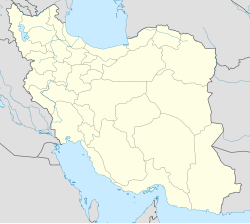History
The modern town of Shahin Dezh was formerly known as Ṣāʾīn Qal‘eh. [7] The name Ṣāʾīn (also spelled Sāīn, Shahin, etcetera.) is derived from the Mongol sayin, which translates as "good". [7]
The local Turkic Afshars were brought to the area from Shiraz at the beginning of the 19th century by Fath-Ali Shah Qajar (r. 1797–1834), the second Qajar shah ("king") of Iran. [7] Later, a segment of these Afshars had to migrate to Urmia in order to make way for the Chardawri (Chardowli) Lurs. [7] The chief of the Chardowli's resided at Mahmuddjik and was the commander of c. 5,000 men. [7] In 1830, Ṣāʾīn Qal‘eh was sacked by Kurds led by Sheikh Ubeydullah. [7] Ṣāʾīn Qal‘eh, being the site of an Iranian military garrison in the past, safeguarded the entrance to the Azerbaijan Province through the Zarrineh valley. [7]
The ancient Karaftu Caves, first described by Robert Ker Porter (1777–1842), and the old site of Takht-e Soleyman were formerly located in the territory of the Afshars of Ṣāʾīn Qal‘eh. [7] The lake of Chamli Göl, near the village of Badarli with its floating island were likewise well known at the time. [7] Some of the Afshars of Ṣāʾīn Qal‘eh belonged to the Yarsanism sect. [7]
The old site of Ṣāʾīn Qal‘eh is now occupied by the modern town of Shahin Dezh, which is also the chef-lieu of Shahin Dezh County. In c. 1950, its population was 3,170 which by 1991 had increased to 25,050. [7]
The fortress of Ṣāʾīn Qal‘eh is sometimes confused with the similarly named fortress on the Abhar river to the east of Soltaniyeh, which was mentioned by Hamdallah Mustawfi (1281 – after 1339/40). [7]
This page is based on this
Wikipedia article Text is available under the
CC BY-SA 4.0 license; additional terms may apply.
Images, videos and audio are available under their respective licenses.


